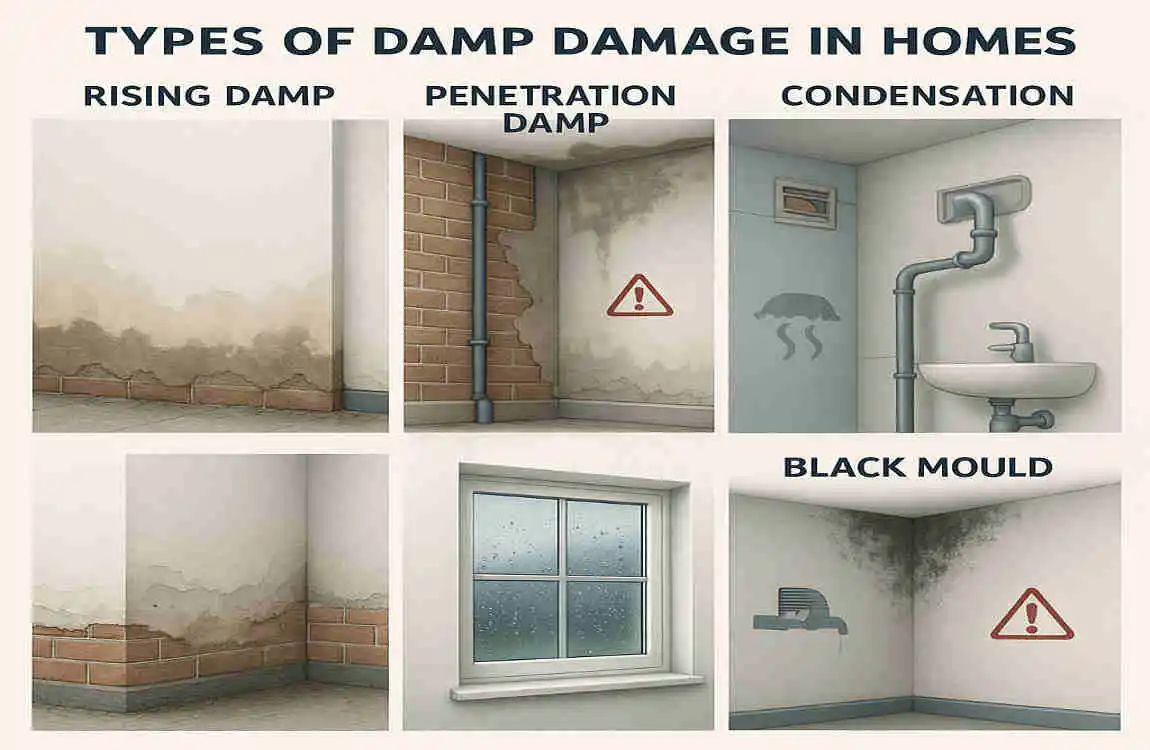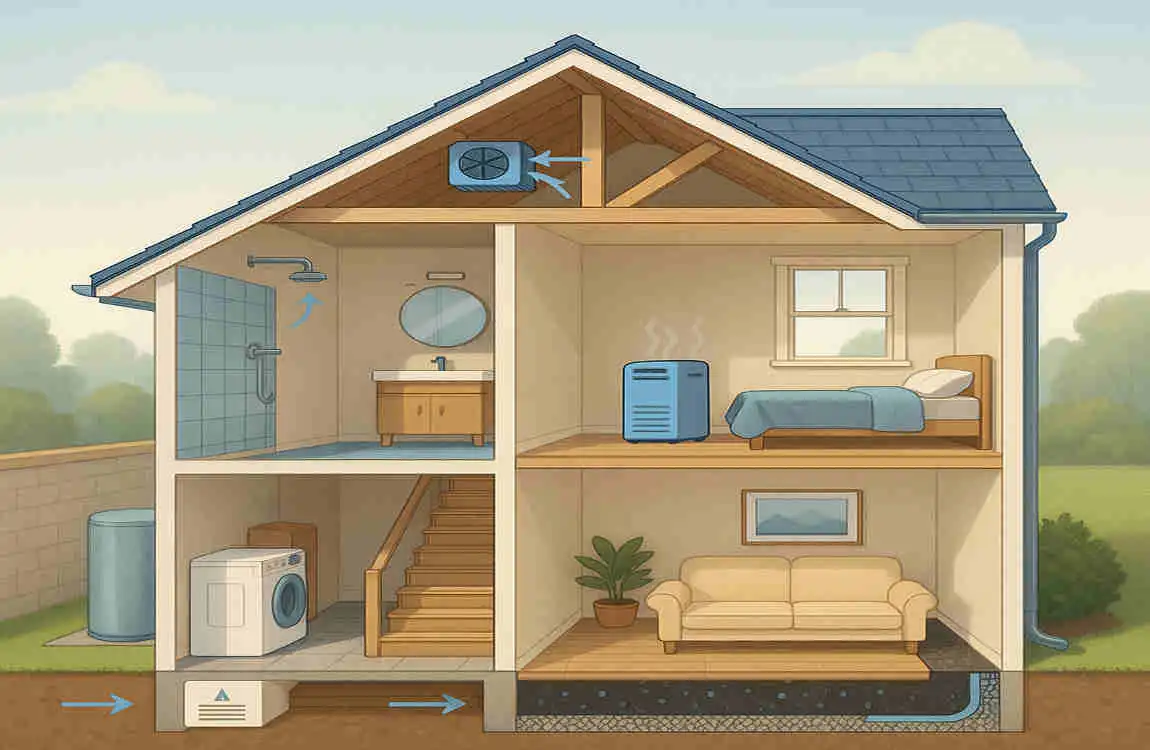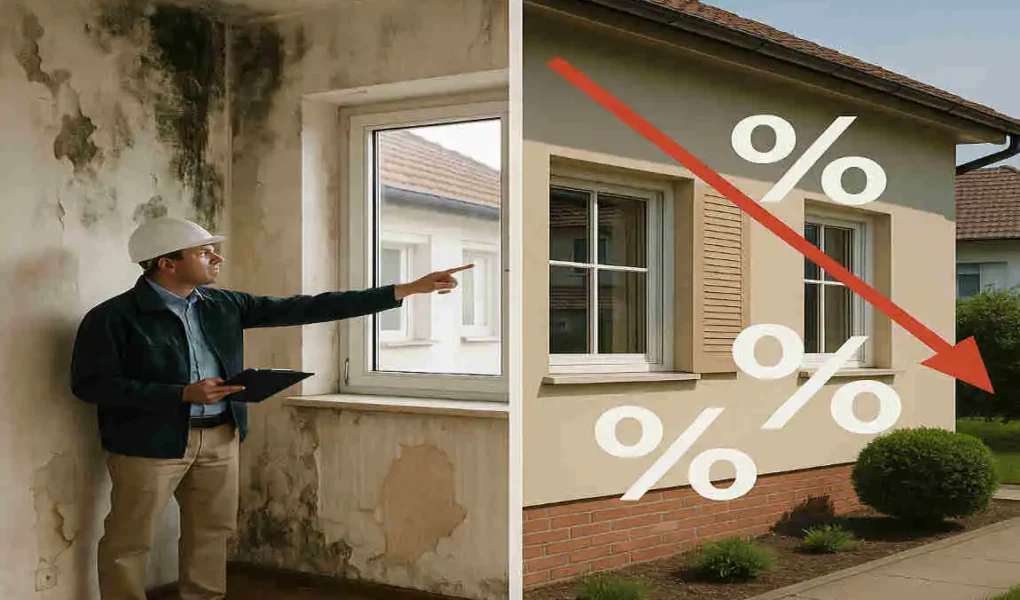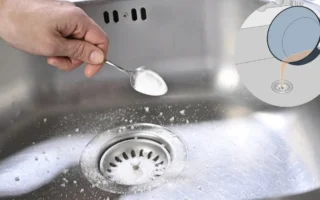When it comes to your home, its value is more than just a number. It’s a reflection of your investment, your hard work, and your future plans. But did you know that damp damage can significantly impact your property’s value?
Damp damage is a common issue that can affect homes of all ages and sizes. It occurs when excess moisture seeps into the building’s structure, causing a range of problems from cosmetic blemishes to structural weaknesses.
What Is Damp Damage? Types and Causes

Defining Damp Damage and Its Signs
Damp damage results from excess moisture in a building’s structure. It can manifest in various ways, from unsightly stains and peeling paint to more serious issues like mould growth and structural decay. Some common signs of damp damage include:
- Discolouration or staining on walls and ceilings
- Peeling wallpaper or paint
- Musty odors
- Visible mould or mildew growth
- Soft or crumbling plaster
If you notice any of these signs in your home, it’s essential to address the issue promptly to prevent further damage and protect your property’s value.
Types of Damp
Three main types of damp can affect your home:
Rising Damp
Rising damp occurs when moisture from the ground rises up through the walls of a building. It’s most common in older properties without a proper damp-proof course (DPC) or in areas with high water tables. Signs of rising damp include tide marks on walls, damaged skirting boards, and a musty smell.
Penetrating Damp
Penetrating damp occurs when water enters the building from the outside, often due to issues such as leaking roofs, faulty gutters, or cracks in the walls. It can cause stains, mould growth, and structural damage to the building. Look for signs like damp patches on walls or ceilings, especially after heavy rain.
Condensation Damp
Condensation damp occurs when excess moisture in the air condenses onto cold surfaces, such as walls and windows. It’s often a result of poor ventilation, high humidity levels, or inadequate heating. Signs of condensation damp include mould growth in areas with poor air circulation, such as bathrooms and kitchens, and water droplets on windows.
Common Causes of Damp
Understanding the causes of damp is crucial to preventing and addressing it. Some common causes include:
- Poor ventilation, leading to condensation
- Plumbing leaks or faulty drainage systems
- Building defects, like cracks or gaps in walls
- Inadequate insulation, causing cold surfaces to attract moisture
By identifying and addressing these causes, you can take proactive steps to protect your home from damp damage and preserve its value.
Why Addressing Damp Is Critical
Ignoring damp damage can have serious consequences for your property’s health and value. Damp can weaken the building’s structure, leading to costly repairs and potential safety hazards. It can also create an environment conducive to mould growth, which can lead to health issues for occupants.
Moreover, damp damage can significantly impact your property’s marketability and resale value. Buyers are often wary of homes with damp issues, as they may see it as a sign of neglect or a costly problem to fix. By addressing damp promptly, you can protect your investment and maintain your home’s value.
How Damp Damage Affects Property Value: The Basics
Impact on Structural Integrity and Aesthetics
Damp damage can have a profound impact on your property’s structural integrity and aesthetics. When moisture seeps into the building’s walls, floors, or ceilings, it can weaken the materials and cause them to deteriorate over time. This can lead to issues like crumbling plaster, rotting wood, and even structural collapse in severe cases.
From an aesthetic standpoint, damp damage can manifest as unsightly stains, peeling paint, and mould growth. These visual blemishes can make your home less appealing to potential buyers and reduce its overall value.
Impact on Buyer Perception and Marketability
When it comes to selling your home, first impressions matter. If a potential buyer notices signs of damp during a viewing, it can raise red flags and prompt them to question the property’s overall condition. They may worry about the cost and hassle of repairing the damage, which can lead to lower offers or even lost sales.
In a competitive real estate market, homes with damp issues may take longer to sell and require larger price reductions to attract buyers. By addressing damp damage before listing your home, you can improve its marketability and protect its value.
Risk of Costly Repairs and Health Issues
Ignoring damp damage can lead to costly repairs down the line. As the damage worsens, the cost of remediation can increase exponentially. In some cases, extensive repairs may be necessary, such as replacing damaged walls or floors, which can be a significant financial burden for homeowners.
Moreover, damp damage can create a conducive environment for mould growth, posing health risks to occupants. Mould spores can trigger allergies, respiratory issues, and other health problems, especially among vulnerable individuals such as children, the elderly, and those with compromised immune systems. By addressing damp promptly, you can protect your family’s health and well-being and avoid costly medical bills.
Link Back to Keyword: “How Much Does Damp Devalue a House”
Now that we’ve explored the various ways in which damp damage can affect your property, let’s dive into the question at hand: how much does damp devalue a house? In the next section, we’ll look at industry data and case studies to quantify the impact of damp on property prices.
Quantifying Damp Damage Impact on House Prices
Typical Property Devaluation Percentages
The extent to which damp damage devalues a property can vary depending on several factors, including the severity of the damage, the type of property, and the local real estate market. However, industry data suggests that damp damage can typically reduce a property’s value by anywhere from 10% to 25% or more.
A study by the Royal Institution of Chartered Surveyors (RICS) found that properties with significant damp issues could see a value reduction of up to 20%. Another study by the Property Care Association (PCA) estimated that damp damage could devalue a property by 10-15% on average, with more severe cases leading to even greater reductions.
Variables Influencing Devaluation
Several variables can influence the extent to which damp damage devalues a property:
- Severity of the damage: More extensive or severe damp issues will typically lead to a greater reduction in property value.
- Location: Properties in areas with high demand or strong real estate markets may see a minor value reduction due to damp, as buyers may be more willing to overlook the issue.
- Type of property: Older properties or those with a history of damp problems may be more susceptible to devaluation than newer or well-maintained homes.
- Market conditions: In a buyer’s market, where there are more properties available than buyers, damp damage may have a more significant impact on value than in a seller’s market.
Examples of Price Reductions
To illustrate the impact of damp damage on property prices, let’s look at a few examples from different markets:
- Urban vs. Rural: In a study of properties in London, damp damage was found to reduce the average sale price by around 15%. In contrast, a similar study in rural areas found that damp could devalue properties by up to 25%, as buyers in these areas may have more options and be less willing to take on the risk of damp issues.
- Old vs. New Homes: A survey of properties in the UK found that damp damage in homes built before 1940 could reduce value by up to 20%, while newer homes (built after 1980) saw an average decrease of around 10%. This suggests that buyers may be more concerned about damp in older properties, which may have a history of issues or be more susceptible to damage.
Estimated Costs Buyers Subtract
When a potential buyer discovers damp damage during an inspection, they may factor in the cost of repairs when making an offer on the property. According to industry estimates, buyers may subtract the following amounts from their offer to account for damp damage:
- Mild damp issues: £1,000 – £5,000
- Moderate damp issues: £5,000 – £10,000
- Severe damp issues: £10,000 – £20,000 or more
Keep in mind that these are rough estimates, and the actual cost of repairs can vary depending on the extent of the damage and the size of the property. However, they give you an idea of how much buyers may deduct from their offer to account for damp issues.
Damp Damage vs. Other Property Defects: A Value Comparison
When it comes to property defects, damp damage is just one of many issues that can impact your home’s value. Let’s take a look at how damp compares to other common defects in terms of average devaluation, severity, repair costs, and buyer concern:
Defect Type Average Devaluation (%)Severity Level Repair Cost Estimate Buyer Concern Level
Damp Damage 10-25%+ High Moderate to High High
Roof Damage 15-30% High High Very High
Structural Issues 20-40%+ Very High Very High Very High
Cosmetic Damage 5-10% Low Low Low to Moderate
As you can see, damp damage falls in the middle of the pack in terms of average devaluation, with a typical reduction of 10-25% or more. However, it’s considered a high-severity issue, as it can lead to structural damage and health concerns if left unaddressed.
In comparison, roof damage and structural issues can have an even greater impact on property value, with average devaluations of 15-30% and 20-40%+, respectively. These issues are also considered high to very high severity, as they can compromise the safety and integrity of the building.
On the other end of the spectrum, cosmetic damage, such as outdated decor or minor wear and tear, typically has a lower impact on property value, with an average devaluation of 5-10%. These issues are considered low severity and are often easier and less costly to address.
When it comes to buyer concern, damp damage ranks high, as potential buyers may worry about the cost and hassle of repairs, as well as the possible health risks associated with mould growth. Roof damage and structural issues rank even higher in terms of buyer concern, as they can be more expensive to fix and may pose safety hazards.
By understanding how damp damage compares to other property defects, you can better assess the potential impact on your home’s value and prioritise repairs and maintenance accordingly.
How Damp Damage Influences Buyer Behaviour and Marketability
Damp damage can significantly impact how potential buyers perceive and interact with your property. Let’s explore some of how damp can influence buyer behaviour and marketability:
Delays in Sale Due to Inspections and Repairs
When a potential buyer discovers damp damage during a viewing or inspection, it can delay the sale process. They may request additional inspections or surveys to assess the extent of the damage and the cost of repairs, which can delay closing the deal.
In some cases, buyers may even pull out of the sale altogether if they feel that the damp issues are too severe or costly to address. This can be frustrating for sellers, who may need to relist the property and restart the sales process.
Lower Offers and Negotiation Leverage
When a buyer discovers damp damage, they may use it as a bargaining chip to negotiate a lower offer on the property. They may argue that the cost of repairs should be reflected in the sale price, potentially reducing the final sale amount.
In a competitive market, where there are more properties available than buyers, damp damage can give buyers even more leverage in negotiations. They may be able to secure a better deal or walk away from the sale if the seller is unwilling to lower the price to account for the damp issues.
Impact on Mortgage Approval and Insurance
Damp damage can also impact a buyer’s ability to secure a mortgage or insurance for the property. Lenders and insurers may view damp as a risk factor, as it can lead to costly repairs and potential health hazards for occupants.
In some cases, lenders may require additional surveys or repairs before approving a mortgage, which can delay the sale process. Insurers may also charge higher premiums or exclude coverage for damp-related damage, which can be a concern for buyers.
How Real Estate Agents View Homes with Damp
Real estate agents play a crucial role in the sales process, and their perception of a property can influence how it’s marketed and presented to potential buyers. When it comes to homes with damp damage, agents may view them as more challenging to sell and may advise sellers to address the issue before listing the property.
Agents may also be more cautious when showing homes with dampness to potential buyers, as they may want to manage expectations and avoid any potential disputes or issues during the sales process. By working with an experienced agent who understands the impact of damp on property value, you can develop a strategy to market your home effectively and attract the right buyers.
Signs to Detect Damp Damage Early and Its Importance
Detecting damp damage early is crucial for protecting your property’s value and preventing more severe issues down the line. Let’s explore some of the signs to look out for and why early detection is so important:
Visible Signs of Damp
Some common visible signs of damp damage include:
- Staining or discolouration: Look for tide marks, yellow or brown stains, or damp patches on walls, ceilings, or floors.
- Mould or mildew growth: Mould can appear as black, green, or white patches and often has a musty smell.
- Peeling paint or wallpaper: Dampness can cause paint or wallpaper to bubble, peel, or flake off the surface.
- Musty odours: A persistent musty or damp smell can indicate hidden moisture issues.
If you notice any of these signs in your home, it’s essential to investigate further and address the issue promptly.
Using Moisture Meters and Professional Surveys
In addition to visible signs, you can use moisture meters to detect hidden damp issues. These devices measure the moisture content in building materials and can help identify areas of concern that may not be visible to the naked eye.
For a more comprehensive assessment, consider hiring a professional to conduct a damp survey. These surveys can identify the type and extent of wet damage, its underlying causes, and provide recommendations for remediation.
Importance of Early Detection
Detecting damp damage early is crucial for several reasons:
- Preventing further damage: Addressing damp promptly can help prevent more severe structural issues and costly repairs down the line.
- Protecting property value: By identifying and fixing damp issues early, you can maintain your home’s value and marketability.
- Safeguarding health: Early detection and remediation of damp can help prevent mould growth and related health issues for occupants.
By being proactive and vigilant about detecting damp damage, you can protect your investment and ensure a healthy living environment for your family.
Advice on Regular Home Maintenance and Inspection Tips
To detect damp damage early, it’s essential to perform regular home maintenance and inspections. Here are some tips to help you stay on top of potential issues:
- Check for leaks: Regularly inspect your plumbing, roof, and windows for any signs of leaks or water damage.
- Maintain proper ventilation: Ensure that your home has adequate ventilation, especially in moisture-prone areas like bathrooms and kitchens.
- Monitor humidity levels: Use a hygrometer to monitor indoor humidity, and take steps to reduce moisture if necessary.
- Perform annual inspections: Schedule a comprehensive home inspection at least once a year to identify any potential issues, including damp damage.
By following these tips and staying proactive about home maintenance, you can detect early signs of damp damage and protect your property’s value.
Strategies to Prevent Damp and Protect Your Home’s Value

Preventing damp damage is key to protecting your home’s value and ensuring a healthy living environment. Let’s explore some practical strategies to keep damp at bay:
Proper Ventilation and Heating Solutions
One of the leading causes of damp is poor ventilation, which can lead to condensation and moisture buildup. To prevent this, ensure your home has adequate ventilation, especially in areas prone to moisture, such as bathrooms and kitchens.
Consider installing extractor fans, opening windows regularly, and using trickle vents to improve air circulation. Additionally, maintaining a consistent heating schedule can help keep surfaces warm and reduce the risk of condensation.
Repairing Leaks and Improving Drainage
Leaks from plumbing, roofs, or gutters can contribute to damp damage. Regularly inspect your home for any signs of leaks and address them promptly to prevent moisture from seeping into your walls or floors.
Improving your home’s drainage can also help prevent damp. Ensure that your gutters and downspouts are clear of debris and that water is directed away from your foundation. Consider installing a French drain or other drainage solutions if you live in an area prone to water pooling.
Damp-Proof Course (DPC) Installation and Repair
A damp-proof course (DPC) is a barrier installed in a building’s walls to prevent moisture from rising from the ground. If your home doesn’t have a DPC or if it’s damaged, consider having one installed or repaired by a professional.
A properly functioning DPC can help prevent rising damp and protect your home’s value. Regularly inspect your DPC for any signs of damage or deterioration and address issues promptly.
Using Waterproof Paints and Sealants
Applying waterproof paints and sealants to vulnerable areas can help prevent damp damage. Consider using these products on exterior walls, basements, and other areas prone to moisture.
When choosing waterproof paints or sealants, look for products specifically designed for damp prevention and follow the manufacturer’s instructions for application and maintenance.
Landscaping Tips to Avoid Water Pooling
The way you landscape your property can impact the risk of damp damage. To prevent water from pooling near your foundation, consider the following tips:
- Grade your yard: Ensure that the ground slopes away from your home to direct water away from the foundation.
- Plant moisture-absorbing plants: Choose plants that can help absorb excess moisture, like ferns or certain types of grasses.
- Install a rain garden: Consider creating one to collect and absorb runoff from your roof and gutters.
By implementing these landscaping strategies, you can reduce the risk of water pooling and protect your home from damp damage.




